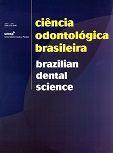Avaliação do efeito de enxaguatórios bucais na rugosidade superficial de resinas acrílicas quimicamente ativadas
DOI:
https://doi.org/10.14295/bds.2009.v12i3.634Abstract
O objetivo neste trabalho foi avaliar o efeito de dois enxaguatórios bucais (Periogard [PER] (Colgate-Palmolive Ind. Com. Ltda – São Paulo, SP, Brasil) e Listerine [LIS] (Johnson & Johnson Healthcare Products – Skillman-NJ,EUA)) na rugosidade de superficie de duas resinas acrílicas polimerizáveis quimicamente (Duralay [DUR] (Reliance Dental – Worth, IL, EUA] e Dencrilay [DEN] (Dencril Caieiras, SP, Brasil)), tendo como grupo controle o soro fisiológico [SOR], totalizando 6 grupos (n=8). Para a confecção dos corpos-de-prova (CP) foram utilizadas 48 matrizes de poliacetal com um orifício central cilíndrico de 5 mm de diâmetro por 5 mm de profundidade. A resina acrílica foi manipulada e inserida no orifício com seringa plástica, com a matriz posicionada sobre uma lâmina de vidro. Outra lâmina foi pressionada sobre a matriz e esse conjunto foi colocado numa panela de pressão durante a polimerização. As faces correspondentes aos diâmetros dos cp foram regularizadas com lixa d’água 220 e as faces que apresentaram menos irregularidades receberam o acabamento com as demais lixas (320, 400, 600, 1200) sob refrigeração com água, em uma politriz. Após 24 horas de armazenagem em água foram realizadas as leituras iniciais num rugosímetro na escala Ra. Os CP foram imersos nas soluções para bochecho durante 10 minutos por dia, por 10 dias. Entre os intervalos de imersão nas soluções para bochechos as resinas ficaram armazenados em soro fisiológico. Nesse período, o grupo controle ficou todo o tempo armazenado em soro fisiológico. Em seguida, os CP foram submetidos à leitura final de rugosidade (Ra), pelo mesmo avaliador. Os resultados iniciais foram: DUR+LIS=0,20; DUR+PER=0,21; DUR+SOR=0,25; DEN+LIS=0,33; DEN+SOR=0,33; DEN+PER=0,36; e finais: DUR+PER=0,28; DUR+LIS=0,28; DEN+SOR=0,31; DUR+SOR=0,34; DEN+PER=0,43; DEN+LIS=0,43. A análise de variância e o teste de Tukey (5%) mostraram que a resina acrílica Duralay apresentou menor rugosidade de superfície e as soluções aumentaram significantemente as suas rugosidades com o tempo. Não houve diferença significante entre as soluções testadas.
Downloads
Downloads
Published
How to Cite
Issue
Section
License
Brazilian Dental Science uses the Creative Commons (CC-BY 4.0) license, thus preserving the integrity of articles in an open access environment. The journal allows the author to retain publishing rights without restrictions.
=================




























